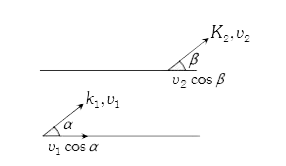IF an electron enters into a space between the plates of a parallel plate capacitor at an an angle α with the plates an leaves at an angle β to the plates find the ratio of its kinetic energy while entering the capacitor of that while leaving.
sin2βcos2β
cosβcosα
cosβsinα
cos2βcos2α
The correct Answer is:D

∵v1cosα=v2cosβ
v1v2=cosβcosα
Then the ratio of kinetic energies
K1K2=12mv2112mv22=(v1v2)2=(cosβcosα)2
K1K2=cos2βcos2α
Similar Questions
एक समान्तर प्लेट संधारित्र की धारिता 15μF है, जबकि इसके प्लेटों के बीच की दूरी 6cm है | यदि प्लेटों के बीच की दूरी घटाकर 2cm कर दी जाये, तो अब इस संधारित्र की धारिता होगी
View SolutionEnergy stored in capacitors|Force between plates of a parallel plate capacitor
View SolutionIf an electron enters into a space between the plates of a parallel plate capacitor at an angle alpha with the plates and leaves at angle beta to the plates. The ratio of its kinetic energy while entering the capacitor to that while leaving will be :
View SolutionAn electron enters with kinetic energy KE_1 , between the plates of a capacitor with a velocity making angle alpha as shown and leaves with KE_2 making angle beta ?. Find (KE_1)/(KE_2) ?
View SolutionAn electron enters the region between the plates of a parallel plate capacitor at an angle θ to the plates. The plate width is l, the plate separation is d. The electron follows the path shown just missing the upper plate. Neglect gravity. Then,

View SolutionAn electron enters into the space of uniform field of finite width making an angle 60∘ to the field lines and leaves at angle 30∘ to the field lines. The ratio of its kinetic energy while entering the electric field to the while leave will be :

View SolutionIF an electron enters into a space between the plates of a parallel plate capacitor at an an angle alpha with the plates an leaves at an angle beta to the plates find the ratio of its kinetic energy while entering the capacitor of that while leaving.
View SolutionParallel plate capacitor #!#Capacitance of parallel plate capacitor #!#Electric field between parallel plate capacitor #!#Potential difference between parallel plate capacitor
View Solution
